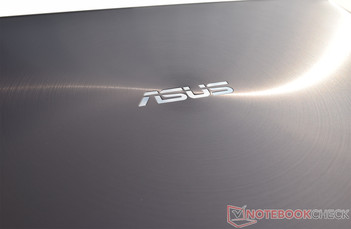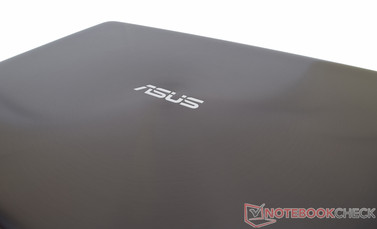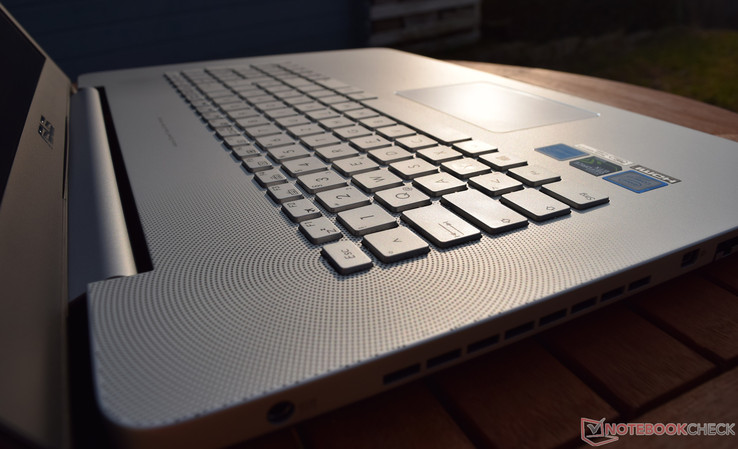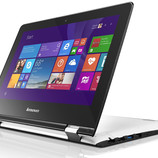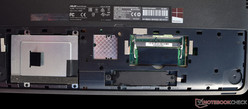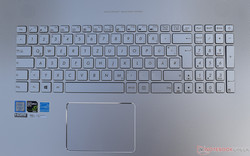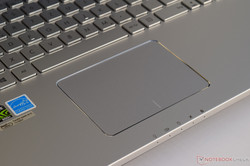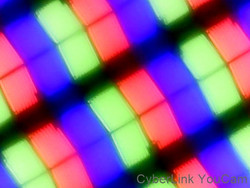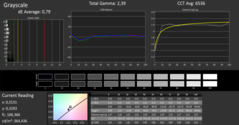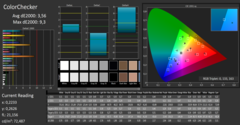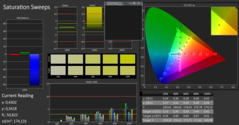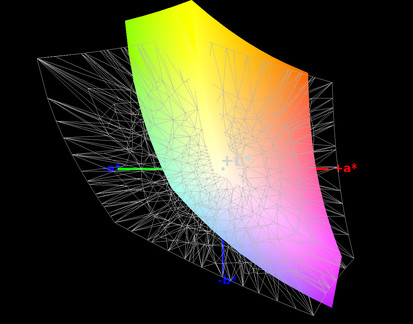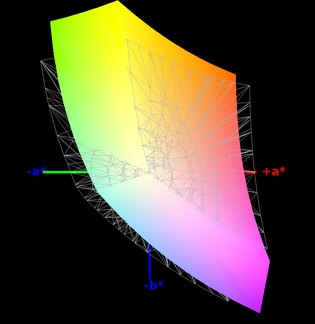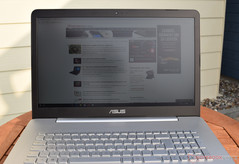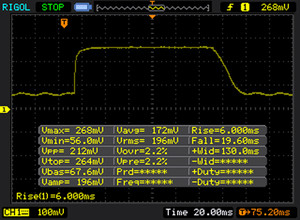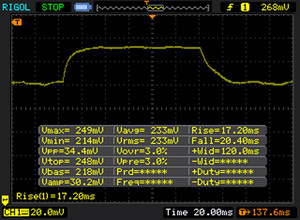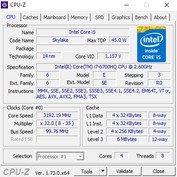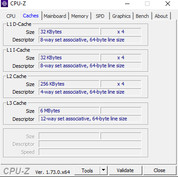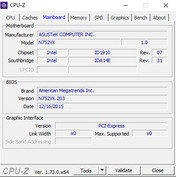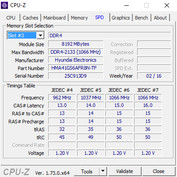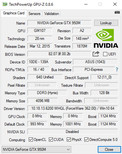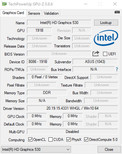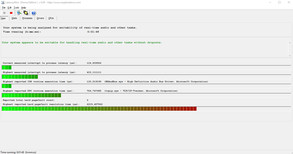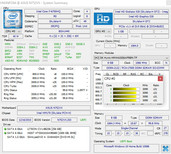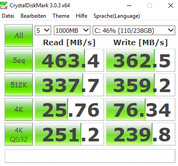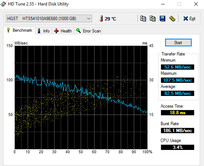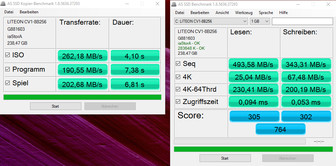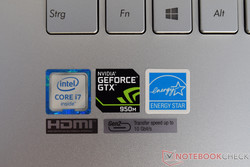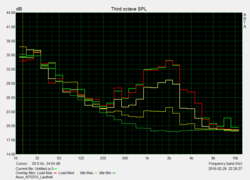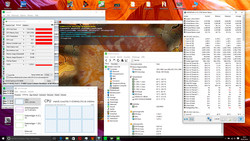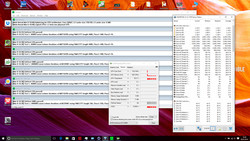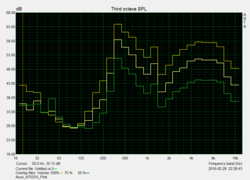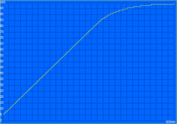Premium with a silver arrow look? The latest ASUS N52VX lineup relies on high-quality built casings with nice highlights. We will clarify what has changed compared with the predecessor, and in which performance category the classy Asus laptop is placed in our in-depth review of the Asus N752VX-GC131T.
For the original German review, see here.
With the N752VX-GC131T Asus has not only updated its 17-inch devices technically, but also their looks. We have tested Asus' N751JX-T4056H extensively. In addition to the plainly visible changes in looks, modifications have also been made "under the hood". A high-performance Intel Core i7 from the Skylake generation, supported by a DDR4 working memory, and a high-quality IPS panel are the most significant innovations. The latest N752VX model lineup by Asus is offered in various configurations. Asus even has a UDH IPS screen available. As for the GPU, Asus offers an Nvidia GeForce GTX 950M here, with either 2 GB or 4 GB of DDR3 VRAM.
Our review sample comes with Intel's Core i7-6700HQ and 8 GB of DDR4 RAM. Nvidia's GeForce GTX 950M with 4 GB of DDR3 VRAM serves as the video accelerator. A 256 GB SSD alongside a 1 TB HDD serves as the storage in our review sample. A good screen with high viewing angles is also included. Asus' N752VX-GC131T is currently priced at 1279 Euros (~$1431). The UHD screen model costs 1699 Euros (~$1900), but it also features a 512 GB SSD instead of the 256 GB unit in our review sample.
The competition among multimedia devices is quite large. To limit the options somewhat, we have selected up-to-date comparison laptops from the 1100 Euros to 1500 Euros (~$1230 to ~$1678) price range. Therefore, we will use the following six devices in this test:
- Asus N751JX-T4056H (1199 Euros/~$1341)
- HP Envy 17-n107ng (1499 Euros/~$1677)
- Acer Aspire V Nitro Black Edition VN7-792G-74Q4 (1230 Euros/~$1376)
- MSI GP72 2QE Leopard Pro (1100 Euros/~$1230)
- MSI PE70-2QEi581 (1299 Euros/~$1453)
- Acer Aspire V Nitro 7-791G (1360 Euros/~$1521)
See our Top 10 Notebooks:
» Multimedia, » Gaming, » Lightweight Gaming
» Budget Office, » Business, » Workstations
» Subnotebooks, » Utrabooks, » Convertibles
» Budget Office, » Business, » Workstations
» Subnotebooks, » Utrabooks, » Convertibles
» Top 10 under 300 Euros, » under 500 Euros
» Best Notebooks for University Students
» Top Windows alternatives to Apple's MacBook series
» Best Notebook Displays
» Best Notebooks for University Students
» Top Windows alternatives to Apple's MacBook series
» Best Notebook Displays
Top 10 Tablets / Smartphones:
Case
Connectivity
Communication
Intel's Dual-Band Wireless-AC 7265 module supports Bluetooth 4.0 and achieves a gross data transmission rate of 867 Mbit/s with 2x 802.11ac. The reception was stable over the entire test period. The connection speed was still within an acceptable range outdoors at a distance of approximately 15 meters (~49 ft) to the router. Cabled networks can still be accessed with Gigabit speeds via the foldable LAN socket. Its performance was at the expected level in the test period.
Security
Asus' N752VX-GC131T is equipped with a Trusted Platform Module 2.0. A Kensington lock slot is also present. However, the user will not find a fingerprint scanner.
Accessories
Asus' N752VX-GC131T does not come with many accessories. Only a cable tie and the classy power supply familiar from the predecessor, matching to the laptop's design with rounded edges. The power supply has a maximum output of 120 watts.
Maintenance
Warranty
Asus includes a 24-month warranty. It is also possible to purchase a 36-month warranty extension for 79 Euros (~$88) via Asus. However, the warranty upgrade has to be bought within the first 12 months of purchase. Asus no longer offers this beyond that period. Since it is an international warranty, it is available in many countries around the world.
Operating System
Asus' N752VX-GC131T is offered with Microsoft's Windows 10 Home 64-bit operating system.
Input Devices
Touchpad
Display
| |||||||||||||||||||||||||
X-Rite i1Pro 2
Maximum: 363 cd/m² Average: 340.4 cd/m² Minimum: 19 cd/m²Brightness Distribution: 88 %
Center on Battery: 354 cd/m²
Contrast: 1041:1 (Black: 0.34 cd/m²)
ΔE Color 3.56 | 1.01-23.34 Ø6.8
ΔE Greyscale 0.79 | 0.79-16.8 Ø7.1
83% sRGB (Calman) 55% AdobeRGB 1998 (Argyll)
Gamma: 2.39
| Asus N752VX-GC131T | Asus N751JX-T4056H | HP Envy 17-n107ng | Acer Aspire V Nitro Black Edition VN7-792G-74Q4 | MSI GP72-2QEi781 | MSI PE70-2QEi581 | Acer Aspire V Nitro 7-791G-70TW | |
|---|---|---|---|---|---|---|---|
| Screen |
-95%
|
-161%
|
-72%
|
-243%
|
-75%
|
-158%
| |
| Brightness Center | 354 | 337
-5%
| 341
-4%
| 346
-2%
| 250
-29%
| 305
-14%
| 347
-2%
|
| Black Level * | 0.34 | 0.61
-79%
| 1.05
-209%
| 0.32
6%
| 0.25
26%
| 0.5
-47%
| 0.409
-20%
|
| Contrast | 1041 | 552
-47%
| 325
-69%
| 1081
4%
| 1000
-4%
| 610
-41%
| 848
-19%
|
| Colorchecker DeltaE2000 * | 3.56 | 5.84
-64%
| 4.6
-29%
| 4.01
-13%
| 10.3
-189%
| 4.83
-36%
| 6.81
-91%
|
| Greyscale DeltaE2000 * | 0.79 | 3.86
-389%
| 6.08
-670%
| 3.58
-353%
| 10.83
-1271%
| 3.29
-316%
| 7.27
-820%
|
| Gamma * | 2.39 | 2.59 | 2.43 | 2.23 | 2.51 | 2.39 | 2.4 |
| Color Space (Percent of AdobeRGB 1998) | 55 | 64
16%
| 62
13%
| 61
11%
| 56
2%
| 57
4%
|
* ... smaller is better
Display Response Times
| ↔ Response Time Black to White | ||
|---|---|---|
| 25 ms ... rise ↗ and fall ↘ combined | ↗ 6 ms rise | |
| ↘ 19 ms fall | ||
| The screen shows relatively slow response rates in our tests and may be too slow for gamers. In comparison, all tested devices range from 0.8 (minimum) to 240 (maximum) ms. » 31 % of all devices are better. This means that the measured response time is better than the average of all tested devices (29.1 ms). | ||
| ↔ Response Time 50% Grey to 80% Grey | ||
| 34 ms ... rise ↗ and fall ↘ combined | ↗ 17 ms rise | |
| ↘ 20 ms fall | ||
| The screen shows slow response rates in our tests and will be unsatisfactory for gamers. In comparison, all tested devices range from 0.9 (minimum) to 92 (maximum) ms. » 21 % of all devices are better. This means that the measured response time is better than the average of all tested devices (42.7 ms). | ||
Screen Flickering / PWM (Pulse-Width Modulation)
| Screen flickering / PWM not detected | ||
In comparison: 53 % of all tested devices do not use PWM to dim the display. If PWM was detected, an average of 603 (minimum: 43 - maximum: 10420) Hz was measured.
| ||
Performance
Processor
Asus relies on a high-performance Intel Core i7-6700HQ processor for its latest model. It was introduced in September 2015 and is built in the modern 14 nm process. Using the new Skylake CPUs allows increasing the performance slightly compared to the predecessor that was still equipped with an Intel Core i7-4720HQ.
Intel's Core i7-6700HQ has a standard base clock of 2.6 GHz, which can be boosted up to 3.5 GHz on one core or 3.1 GHz on 4 cores via Turbo depending on the load and application. This processor currently belongs to the upper performance range with four physical cores.
The CPU shows what it is made of in Cinebench. The performance level is within the expected range. However, the rivals are sometimes outperformed probably because the benchmarks were not affected by throttling. The maximum clock of 3.1 GHz in multi-core and 3.5 GHz in single-core benchmarks could always be retrieved.
The very good single-core performance in the Cinebench tests is worthy of mention. Our review sample could sometimes clearly outrun its rivals in the tests. For example, Asus' N752VX-GC131T calculated the Cinebench R15 CPU Single 64-bit test 11% faster than HP's Envy 17-n107ng based on the same CPU.
System Performance
Thanks to the good hardware configuration, the system performance does not present any nasty surprises. The system is booted and ready to go in just 12 seconds. Overall, the laptop runs smoothly. We did not encounter any problems during the test period. The relatively strong processor will hardly reach its limits in routine use. Furthermore, Nvidia's GeForce GTX 950M is not throttled and can develop its full potential. In addition, the installed SSD in the full-size M.2 format supports smooth workflow and fast system booting. 8 GB of DDR4 working memory is sufficient. However, an empty slot for another RAM module is present under the maintenance hatch. Asus' laptop even features a second generation USB 3.1 Type-C port for external data transfer. The sticker below the keyboard emphasizes that.
| PCMark 8 | |
| Home Score Accelerated v2 | |
| Acer Aspire V Nitro Black Edition VN7-792G-74Q4 | |
| HP Envy 17-n107ng | |
| Asus N752VX-GC131T | |
| MSI GP72-2QEi781 | |
| Asus N751JX-T4056H | |
| MSI PE70-2QEi581 | |
| Creative Score Accelerated v2 | |
| HP Envy 17-n107ng | |
| Acer Aspire V Nitro Black Edition VN7-792G-74Q4 | |
| Asus N752VX-GC131T | |
| Asus N751JX-T4056H | |
| Work Score Accelerated v2 | |
| HP Envy 17-n107ng | |
| Asus N752VX-GC131T | |
| Acer Aspire V Nitro Black Edition VN7-792G-74Q4 | |
| MSI GP72-2QEi781 | |
| MSI PE70-2QEi581 | |
| Asus N751JX-T4056H | |
| PCMark 7 Score |
| 5268 points |
| PCMark 8 Home Score Accelerated v2 |
| 3480 points |
| PCMark 8 Creative Score Accelerated v2 |
| 4110 points |
| PCMark 8 Work Score Accelerated v2 |
| 4756 points |
Help
Discussion
Storage Devices
The review sample we have been provided with is equipped with two storage solutions. The operating system is on a 256 GB SSD in M.2 format. Thus, there is still enough storage capacity for frequently used applications. The Lite-On SSD achieved a read rate of 490 MB/s and write rate of 340 MB/s in the AS SSD test. These rates are good, and the SSD clearly ensures smooth and quiet operation.
An additional 2.5-inch hard drive by HGST is available should the 256 GB not be enough. The conventional hard drive has a capacity of 1 TB and achieves an average transfer rate of 82.5 MB/s in HD Tune - a normal rate for a conventional hard drive that spins at 5400 revolutions per minute.
Both storage devices can be accessed via the maintenance hatch. However, upgrading the storage would only be possible by replacing one or both modules since both slots are filled.
| Asus N752VX-GC131T | Asus N751JX-T4056H | HP Envy 17-n107ng | Acer Aspire V Nitro Black Edition VN7-792G-74Q4 | MSI GP72-2QEi781 | Acer Aspire V Nitro 7-791G-70TW | |
|---|---|---|---|---|---|---|
| CrystalDiskMark 3.0 |
-91%
|
18%
|
-90%
|
-89%
|
-4%
| |
| Read Seq | 463.4 | 103.5
-78%
| 517.5
12%
| 113.8
-75%
| 106.1
-77%
| 498.1
7%
|
| Write Seq | 362.5 | 97.71
-73%
| 433.1
19%
| 106.6
-71%
| 105.7
-71%
| 351.2
-3%
|
| Read 512 | 337.7 | 33.37
-90%
| 386
14%
| 35.33
-90%
| 40.3
-88%
| 337.1
0%
|
| Write 512 | 359.2 | 29.55
-92%
| 379
6%
| 48.78
-86%
| 56.3
-84%
| 351.6
-2%
|
| Read 4k | 25.76 | 0.411
-98%
| 27.02
5%
| 0.539
-98%
| 0.54
-98%
| 24.72
-4%
|
| Write 4k | 76.34 | 0.872
-99%
| 85.23
12%
| 0.786
-99%
| 1.253
-98%
| 71.25
-7%
|
| Read 4k QD32 | 251.2 | 0.76
-100%
| 370
47%
| 0.197
-100%
| 1.325
-99%
| 179.9
-28%
|
| Write 4k QD32 | 239.8 | 0.883
-100%
| 309.5
29%
| 0.774
-100%
| 1.341
-99%
| 250
4%
|
Graphics Card
Asus' N752VX-GC131T is equipped with a GeForce GTX 950M. Since it is the successor of theGeForce GTX 850M, there are no technical differences. The GTX 950M clocks at a base speed of 993 MHz in the Asus, and can be boosted up to 1124 MHz via Turbo. The 4 GB of DDR3 video memory clocks at 1001 MHz. The 3DMark scores show that all laptops with a GeForce GTX 950M are on par. However, devices with a GeForce GTX 960M achieve better outcomes.
In addition to Nvidia's GeForce GTX 950M GPU, Intel's HD Graphics 530 graphics chip is also inside the laptop. Intel's solution is responsible for routine and battery mode. Nvidia's GPU takes care of performance-driven applications like computer games. Switching between both graphics solutions is performed automatically in the background. The end user does not notice anything at all.
| 3DMark (2013) | |
| 1280x720 Cloud Gate Standard Score | |
| Acer Aspire V Nitro Black Edition VN7-792G-74Q4 | |
| Acer Aspire V Nitro 7-791G-70TW | |
| Asus N752VX-GC131T | |
| HP Envy 17-n107ng | |
| MSI GP72-2QEi781 | |
| Asus N751JX-T4056H | |
| MSI PE70-2QEi581 | |
| 1920x1080 Fire Strike Standard Score | |
| Acer Aspire V Nitro Black Edition VN7-792G-74Q4 | |
| Acer Aspire V Nitro 7-791G-70TW | |
| MSI PE70-2QEi581 | |
| MSI GP72-2QEi781 | |
| Asus N752VX-GC131T | |
| Asus N751JX-T4056H | |
| HP Envy 17-n107ng | |
| 3DMark 06 Standard |
| 21612 points |
| 3DMark Vantage P Result no PhysX |
| 15771 points |
| 3DMark 11 Performance |
| 4596 points |
| 3DMark (2013) Ice Storm Standard Score |
| 62475 points |
| 3DMark (2013) Cloud Gate Standard Score |
| 14469 points |
| 3DMark (2013) Fire Strike Standard Score |
| 2866 points |
| 3DMark (2013) Fire Strike Extreme Score |
| 1482 points |
Help
Gaming Performance
| low | med. | high | ultra | ||
| BioShock Infinite (2013) | 76.6 | 64.79 | 59.43 | 27.29 | fps |
| Battlefield 4 (2013) | 79.14 | 71 | 57.52 | 23.5 | fps |
| Thief (2014) | 64.4 | 49.5 | 41 | 20.5 | fps |
| GRID: Autosport (2014) | 172.46 | 104.7 | 73.35 | 35.33 | fps |
| F1 2014 (2014) | 121 | 103 | 96 | 73 | fps |
| GTA V (2015) | 108.64 | 95.7 | 27.83 | 11.48 | fps |
| Dirt Rally (2015) | 164.72 | 90 | 56.59 | 24.08 | fps |
| Batman: Arkham Knight (2015) | 53 | 47 | 24 | 24 | fps |
| Rainbow Six Siege (2015) | 120.9 | 77.7 | 40.4 | 33.3 | fps |
| Rise of the Tomb Raider (2016) | 57.97 | 35.37 | 20.19 | 16.32 | fps |
| Far Cry Primal (2016) | 51 | 23 | 21 | 14 | fps |
| The Division (2016) | 54.52 | 39.57 | 18.92 | 14.21 | fps |
Emissions
Noise Level
| Idle |
31.5 / 32 / 33.9 dB(A)
| ||||
| DVD | 34.6 / dB(A) | ||||
| Load | 34.6 / 41.7 dB(A) | ||||
 | |||||
30 dB
silent
40 dB(A)
audible
50 dB(A)
loud | |||||
min:
| |||||
Temperature
Speakers
Energy Management
Power Consumption
There is nothing special about the power consumption. A direct comparison with the predecessor shows an improvement in energy requirement. We measured an idle consumption of 15.5 watts. A maximum full load power consumption of 108 watts was recorded. The power supply's output of 120 watts is also sufficient. These rates are absolutely satisfactory in view of the installed hardware components. However, we would not call them ideal. HP's Envy17-n107ng shows the technical possibilities. Asus is on the right path with its N752VX-GC131T.
| Asus N752VX-GC131T | Asus N751JX-T4056H | HP Envy 17-n107ng | Acer Aspire V Nitro Black Edition VN7-792G-74Q4 | MSI GP72-2QEi781 | MSI PE70-2QEi581 | Acer Aspire V Nitro 7-791G-70TW | |
|---|---|---|---|---|---|---|---|
| Power Consumption | |||||||
| Idle Minimum * | 7 | 9.1
-30%
| 5.5
21%
| 5.8
17%
| 13.8
-97%
| 19.1
-173%
| 5.8
17%
|
| Idle Average * | 12.8 | 13.8
-8%
| 10.8
16%
| 9
30%
| 19.6
-53%
| 24.3
-90%
| 13.1
-2%
|
| Idle Maximum * | 15.2 | 17.8
-17%
| 11
28%
| 14.7
3%
| 23.2
-53%
| 29.2
-92%
| 14.5
5%
|
| Load Average * | 80 | 89.7
-12%
| 72
10%
| 85
-6%
| 78.8
1%
| 88.6
-11%
| 98
-23%
|
| Load Maximum * | 108 | 92.3
15%
| 85
21%
| 121.5
-13%
| 103.2
4%
| 122
-13%
| 104.9
3%
|
* ... smaller is better
Power Consumption
| Off / Standby | |
| Idle | |
| Load | |
| Key: min: | |
Battery Runtime
Battery Runtime
| Idle (without WLAN, min brightness) |
| 7h 08min |
| WiFi Surfing v1.3 (EDGE: 25.10586.0.0) |
| 3h 57min |
| Load (maximum brightness) |
| 1h 19min |
| Asus N752VX-GC131T 48 Wh | Asus N751JX-T4056H 56 Wh | HP Envy 17-n107ng 62 Wh | Acer Aspire V Nitro Black Edition VN7-792G-74Q4 53 Wh | MSI GP72-2QEi781 42 Wh | MSI PE70-2QEi581 41 Wh | Acer Aspire V Nitro 7-791G-70TW 53 Wh | |
|---|---|---|---|---|---|---|---|
| Battery Runtime | |||||||
| Reader / Idle | 428 | 898
110%
| 410
-4%
| 359
-16%
| 345
-19%
| ||
| Load | 79 | 73
-8%
| 96
22%
| 50
-37%
| 61
-23%
| ||
| WiFi v1.3 | 237 | 244
3%
| 452
91%
| 254
7%
| 160
-32%
| 158
-33%
| 204
-14%
|
Verdict
Asus N752VX-GC131T - 03/17/2016 v5
Sebastian Bade
Sebastian Bade
Multimedia - Weighted Average

